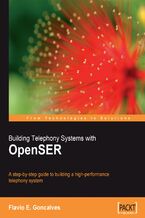
Building Telephony Systems with OpenSIPS. Build high-speed and highly scalable telephony systems using OpenSIPS - Second Edition Flavio E. Goncalves, Bogdan-Andrei Iancu




- Autorzy:
- Flavio E. Goncalves, Bogdan-Andrei Iancu
- Wydawnictwo:
- Packt Publishing
- Ocena:
- Stron:
- 384
- Dostępne formaty:
-
PDFePubMobi
 opcje wysyłki »
opcje wysyłki »
Opis
książki
:
Building Telephony Systems with OpenSIPS. Build high-speed and highly scalable telephony systems using OpenSIPS - Second Edition
This book will give you a competitive edge by helping you to create a SIP infrastructure capable of handling tens of thousands of subscribers.
Starting with an introduction to SIP and OpenSIPS, you will begin by installing and configuring OpenSIPS. You will be introduced to OpenSIPS Scripting language and OpenSIPS Routing concepts, followed by comprehensive coverage of Subscriber Management. Next, you will learn to install, configure, and customize the OpenSIPS control panel and explore dialplans and routing. You will discover how to manage the dialog module, accounting, NATTraversal, and other new SIP services. The final chapters of the book are dedicated to troubleshooting tools, SIP security, and advanced scenarios including TCP/TLS support, load balancing, asynchronous processing, and more.
A fictional VoIP provider is used to explain OpenSIPS and by the end of the book, you will have a simple but complete system to run a VoIP provider.
Wybrane bestsellery
Packt Publishing - inne książki
Dzięki opcji "Druk na żądanie" do sprzedaży wracają tytuły Grupy Helion, które cieszyły sie dużym zainteresowaniem, a których nakład został wyprzedany.
Dla naszych Czytelników wydrukowaliśmy dodatkową pulę egzemplarzy w technice druku cyfrowego.
Co powinieneś wiedzieć o usłudze "Druk na żądanie":
- usługa obejmuje tylko widoczną poniżej listę tytułów, którą na bieżąco aktualizujemy;
- cena książki może być wyższa od początkowej ceny detalicznej, co jest spowodowane kosztami druku cyfrowego (wyższymi niż koszty tradycyjnego druku offsetowego). Obowiązująca cena jest zawsze podawana na stronie WWW książki;
- zawartość książki wraz z dodatkami (płyta CD, DVD) odpowiada jej pierwotnemu wydaniu i jest w pełni komplementarna;
- usługa nie obejmuje książek w kolorze.
Masz pytanie o konkretny tytuł? Napisz do nas: sklep@helion.pl
Książka drukowana

































Oceny i opinie klientów: Building Telephony Systems with OpenSIPS. Build high-speed and highly scalable telephony systems using OpenSIPS - Second Edition Flavio E. Goncalves, Bogdan-Andrei Iancu
(0)